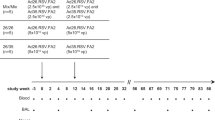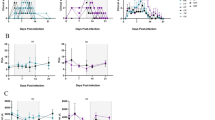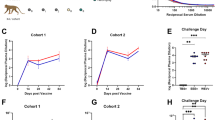Abstract
The severe disease atypical measles occurred when individuals immunized with a poorly protective inactivated vaccine contracted measles, and was postulated to be due to a lack of fusion-inhibiting antibodies. Here, rhesus macaques immunized with formalin-inactivated measles vaccine developed transient neutralizing and fusion-inhibiting antibodies, but no cytotoxic T-cell response. Subsequent infection with measles virus caused an atypical rash and pneumonitis, accompanied by immune complex deposition and an increase in eosinophils. Fusion-inhibiting antibody appeared earlier in these monkeys than in non-immunized monkeys. These data indicate that atypical measles results from previous priming for a nonprotective type 2 CD4 T-cell response rather than from lack of functional antibody against the fusion protein.
This is a preview of subscription content, access via your institution
Access options
Subscribe to this journal
Receive 12 print issues and online access
$209.00 per year
only $17.42 per issue
Buy this article
- Purchase on Springer Link
- Instant access to full article PDF
Prices may be subject to local taxes which are calculated during checkout




Similar content being viewed by others
References
Albrecht, P., Ennis, F.A., Saltzman, E.J. & Krugman, S. Persistence of maternal antibody in infants beyond 12 months: Mechanism of measles vaccine failure J.Pediatr. 91, 715 –178 (1977).
Gans, H.A. et al. Deficiency of the humoral immune response to measles vaccine in infants immunized at age 6 months. J. Am. Med. Assoc. 280, 527–532 (1998).
Holt, E.A., Moulton, L.H., Siberry, G.K. & Halsey, N.A. Differential mortality by measles vaccine titer and sex. J. Infect. Dis. 168, 1087–1096 ( 1993).
Berry, S. et al. Comparison of high titer Edmonston-Zagreb, Biken-CAM and Schwarz measles vaccines in Peruvian infants. Pediatr. Infect. Dis. J. 11, 822–827 ( 1992).
Garenne, M., Leroy, O., Beau, J.-P. & Sene, I. Child mortality after high-titre measles vaccines: prospective study in Senegal. Lancet 338, 903–907 ( 1991).
Carter, C.H. et al. Serologic response of children to inactivated measles vaccine. J. Am. Med. Assoc. 179, 848– 853 (1962).
Guinee, V.F., Henderson, D.A., Casey, H.L., et al. Cooperative measles vaccine field trial I. Clinical efficacy. Pediatrics 37, 649 –657 (1966).
Fulginiti, V.A., Eller, J.J., Downie, A.W. & Kempe, C.H. Altered reactivity to measles virus: Atypical measles in children previously immunized with inactivated measles virus vaccines. J. Am. Med. Assoc. 202, 1075 (1967).
Martin, D.B., Weiner, L.B., Nieburg, P.I. & Blair, D.C. Atypical measles in adolescents and young adults. Ann. Int. Med. 90, 877–881 ( 1979).
Young, L.W., Smith, D.I. & Glasgow, L.A. Pneumonia of atypical measles. Residual nodular lesions. Am. J. Roentgenol. 110, 439– 448 (1970).
Rauh, L.W. & Schmidt, R. Measles immunization with killed virus vaccine. Am. J. Dis. Child. 109, 232 –237 (1965).
Nader, P.R., Horwitz, M.S. & Rousseau, J. Atypical exanthem following exposure to natural measles: Eleven cases in children previously inoculated with killed vaccine. J. Pediatr. 72, 22–28 ( 1968).
McLean, D.M. et al. Atypical measles following immunization with killed measles vaccine Cand. Med. Assoc. J. 103, 743– 744 (1970).
Centers for Disease Control. Atypical measles - California, 1974-1975. Morb. Mort. Weekly. Rep. 25, 245–246 (1976).
Buser, F. Side reaction to measles vaccination suggesting the Arthus phenomenon. N. Engl. J. Med. 277, 250–251 (1967).
Lennon, R.G. et al. Skin test with measles and poliomyelitis vaccines in recipients of inactivated measles virus vaccine. J. Am. Med. Assoc. 200, 99–104 (1967).
Fulginiti, V.A., Arthur, J.H., Pearlman, D.S. & Kempe, C.H. Altered reactivity to measles virus:Local reactions following attenuated measles virus immunization in children who previously received a combination of inactivated and attenuated vaccines. Am. J. Dis. Child. 115, 67–72 (1968).
Scott, T.F.M. & Bonanno, D.E. Reactions to live-measles-virus vaccine in children previously inoculated with killed-virus vaccine. N. Engl. J. Med. 277, 248–250 (1967).
Krause, P.J., Cherry, J.D., Naiditch, M.J., Deseda-Tous, J. & Walbergh, E.J. Revaccination of previous recipients of killed measles vaccine: Clinical and immunologic studies. J. Pediatr. 93, 565–571 ( 1978).
Fulginiti, V.A. & Arthur, J.H. Altered reactivity to measles virus. J. Pediatr. 75, 609– 616 (1969).
Norrby, E., Enders-Ruckle, G. & ter Meulen, V. Difference in the appearance of antibodies to structural components of measles virus after immunization with inactivated and live virus. J. Infect. Dis. 132, 262– 269 (1975).
Norrby, E. & Gollmar, Y. Identification of measles virus-specific hemolysis-inhibiting antibodies separate from hemagglutination-inhibiting antibodies. Infect. Immun. 11, 231– 239 (1975).
Merz, D.C., Scheid, A. & Choppin, P.W. Importance of antibodies to the fusion glycoprotein of paramyxoviruses in the prevention of spread of infection. J. Exp. Med. 151, 275–288 ( 1980).
Kim, H.W. et al. Respiratory syncytial virus disease in infants despite prior administration of antigenic inactivated vaccine. Am. J. Epidemiol. 89, 422–434 ( 1968).
Fulginiti, V.A. et al. Respiratory virus immunization I. A field trial of two inactivated respiratory virus vaccines; an aqueous trivalent parainfluenza virus vaccine and an alum-precipitated respiratory syncytial virus vaccine. Am. J. Epidemiol. 89, 435–447 (1968).
Connors, M. et al. Pulmonary histopathology induced by respiratory syncytial virus (RSV) challenge of formalin-inactivated RSV-immunized BALB/c mice is abrogated by depletion of CD4+ T cells. J. Virol. 66 , 7444–7451 (1992).
Waris, M., Ziegler, T., Kivivirta, M. & Ruuskanen, O. Rapid detection of respiratory syncytial virus and influenza A virus in cell cultures by immunoperoxidase staining with monoclonal antibodies. J. Clin. Microbiol. 28, 1159–1162 (1990).
Auwaerter, P.G. et al. Measles virus infection in rhesus macaques: Altered immune responses and comparison of the virulence of six different virus strains. J. Infect. Dis. (in the press).
Wild, T.F., Malvoisin, E. & Buckland, R. Measles virus: both the haemagglutinin and fusion glycoproteins are required for fusion. J. Gen. Virol. 72, 439–442 (1991).
Cardoso, A.I., Beauverger, P., Gerlier, D., Wild, T.F. & Rabourdin-Combe, C. Formaldehyde inactivation of measles virus abolishes CD46-dependent presentation of nucleoprotein to murine class I-restricted CTLs but not to class II-restricted helper T cells. Virology 212, 255–258 (1995).
Norrby, E., Lagercrantz, R. & Gard, S. Measles Vaccination VI. Serological and clincal follow-up analysis 18 months after a booster injection. Acta Paediatr. Scand. 55, 457–462 ( 1966).
Hankins, R.W. & Black, F.L. Western blot analyses of measles virus antibody in normal persons and in patients with multiple sclerosis, subacute sclerosing panencephalitis, or atypical measles. J. Clin. Microbiol. 24, 324–329 ( 1986).
Warren, J., Kammer, H. & Gallian, M.J. Immunization of monkeys with an inactivated measles antigen and their response to a subsequent measles infection. Arch. ges Virusforsch 11, 748–753 (1962).
Lentsch, A.B., Czermak, B.J., Bless, N.M. & Ward, P.A. NF-KappaB activation during IgG immune complex-induced lung injury: requirements for TNF-alpha and IL-1beta but not complement. Am. J. Pathol. 152, 1327–1331 (1998).
Warren, J.S., Yabroff, K.R., Remick, D.G., et al. Tumor necrosis factor participates in the pathogenesis of acute immune complex alveolitis in the rat. J. Clin. Invest. 84, 1873–1882 (1989).
Warren, J.S., Barton, P.A. & Jones, M.L. Contrasting roles for tumor necrosis factor in the pathogenesis of IgA and IgG immune complex lung injury. Am. J. Pathol. 138, 581–590 ( 1991).
Hall, W.J. & Hall, C.B. Atypical measles in adolescents: Evaluation of clinical and pulmonary function. Ann. Intern. Med. 90, 882–886 ( 1979).
Annunziato, D. et al. Atypical measles syndrome: Pathologic and serologic findings. Pediatrics 70, 203–209 (1982).
Bellanti, J.A. Biologic significance of the secretory γA immunoglobulins. Pediatrics 48, 715–729 ( 1971).
Bellanti, J.A., Sanga, R.L., Klutinis, B., Brandt, B. & Artenstein, M.S. Antibody responses in serum and nasal secretions of children immunized with inactivated and attenuated measles-virus vaccines. N. Engl. J. Med. 280, 628–633 (1969).
Beauverger, P., Buckland, R. & Wild, F. Establishment and characterisation of murine cells constitutively expressing the fusion, nucleoprotein and matrix proteins of measles virus. J. Virol. Meth. 44, 199– 210 (1993).
Acknowledgements
We thank T. DeLozier and Y. Jeng for technical assistance, J. Rowell for help in establishing the CTL assay and A. Haase for suggestions. This work was supported by research grants AI 35149 (D.E.G.), AI 34577 (K.M.L.) and training grants NS07000 (P.G.A.) AI07417 (A.V.) and AI07541 (A.V.) from the National Institutes of Health and the Pasteur Mérieux Connaught Laboratories Fellowship in Pediatrics (F.P.P.).
Author information
Authors and Affiliations
Corresponding author
Rights and permissions
About this article
Cite this article
Polack, F., Auwaerter, P., Lee, SH. et al. Production of atypical measles in rhesus macaques: Evidence for disease mediated by immune complex formation and eosinophils in the presence of fusion-inhibiting antibody. Nat Med 5, 629–634 (1999). https://doi.org/10.1038/9473
Received:
Accepted:
Issue Date:
DOI: https://doi.org/10.1038/9473
This article is cited by
-
Nebulized fusion inhibitory peptide protects cynomolgus macaques from measles virus infection
Nature Communications (2022)
-
Vaccine-Associated Enhanced Viral Disease: Implications for Viral Vaccine Development
BioDrugs (2021)
-
Edible Vaccines: Promises and Challenges
Molecular Biotechnology (2020)
-
Evolution of T Cell Responses during Measles Virus Infection and RNA Clearance
Scientific Reports (2017)
-
Relevance of the Measles Virus Expression in Cancer - an Update
Pathology & Oncology Research (2016)



